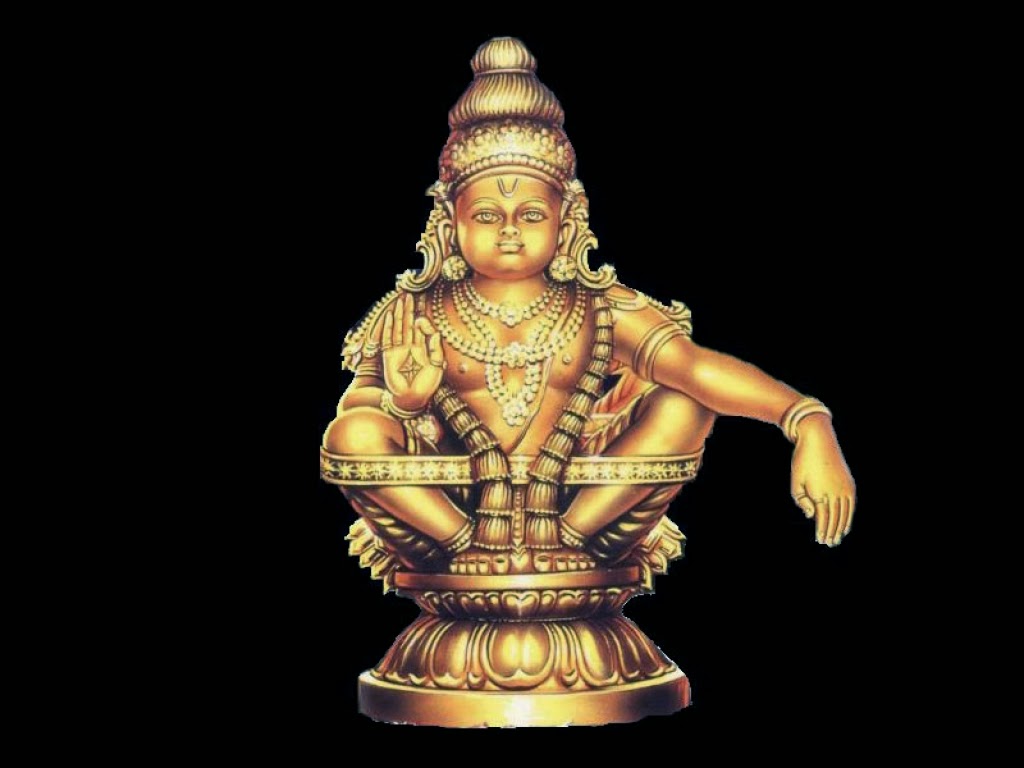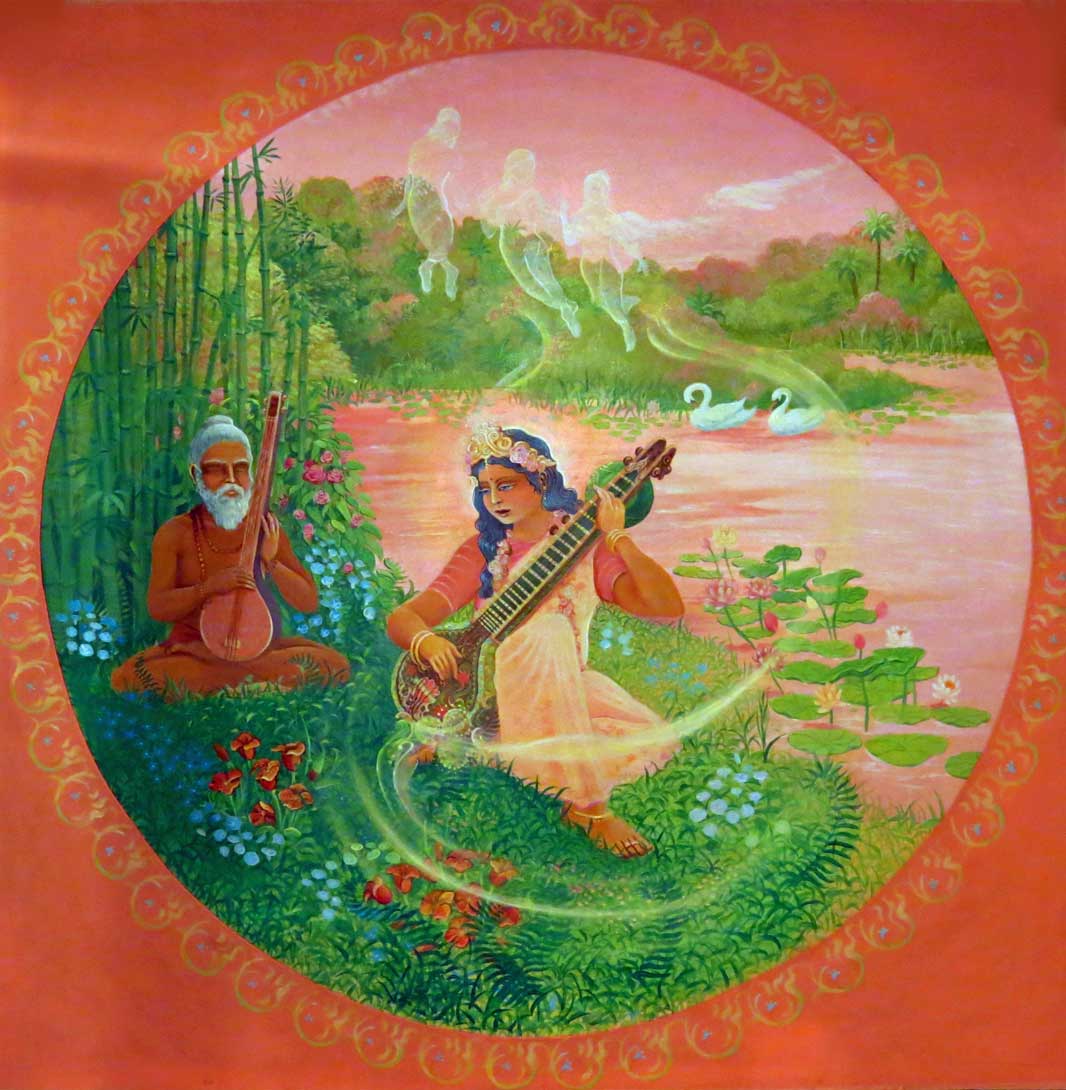 Saraswati Devi DEVI THE DIVINE AS FEMININE The worship of the divine as feminine is
definitely the most ancient form of worship of God. It was prevalent all
over Europe, Greece, Egypt, Arabia and even Africa. With the advent of
Christianity all such worship was condemned as paganism and in Europe,
all temples to goddesses were totally destroyed. In India alone this
tradition has endured and become stronger with the passage of time. No
other living religious tradition displays such an ancient, continuous,
and diverse history of goddess worship. Every village has its own
little niche reserved for its own special goddess that protects and
guards the village. Despite the years of Muslim and colonial rule that
scorned all attempts to depict God as feminine, the Hindus have
continued to worship the mother goddess in her diverse forms.
Hinduism has always recognized and appreciated the supreme role played by the woman in the propagation and nurture of a new generation. Surely this is the most important thing in any society – to ensure that it produces a strong new generation. Three goddesses are invoked in the Rig Veda. They are Saraswati, Ila and Bharati. Another Vedic goddess is Vac who later merged into Saraswati since she is the goddess of learning Both the Vedic Age and the Puranic Age projected and popularised the importance that was to be given to women. In the Vedic Age we find the names of the great women saints like Gargi and Maitreyi who debated in front of an erudite audience with men. In the Puranas we have hundreds of women who were really exemplary and who were the role models for Indian girls until the advent of western indoctrination. Sita, Shakuntala, Savitri, Draupadi, Rugmani, Sathyabhama, Uttara and so on were great examples set before our young girls. All of them were venerated by both women and men till very recently. Now with the advent of western models, women think it’s an insult to be called a Sita or a Savitri! When we look into our Puranas which depict a plethora of gods, we find that goddesses play very important roles. They are never depicted as being inferior to the male gods. On the contrary many of them were far superior. They are all forms of “Shakti” or power and have to be invoked in order to achieve anything in the material world. Lakshmi gives us wealth, Saraswati gives us knowledge, Durga gives us power, Kali gives us strength. Every male God has his own Shakti and their names are invariably placed before his- Lakshmi/Narayana, Gouri/Shankar, Radha/Krishna and so on. Without the power of Shakti, the male gods are incapable of doing anything. This is portrayed in the amazing icon of Kali dancing on the dead body of Shiva. This shows that Shiva without Shakti is only “shava” or a corpse!! This is an example to show that the male is powerless without the female Shakti! Such was the importance placed on women throughout our history and mythology. 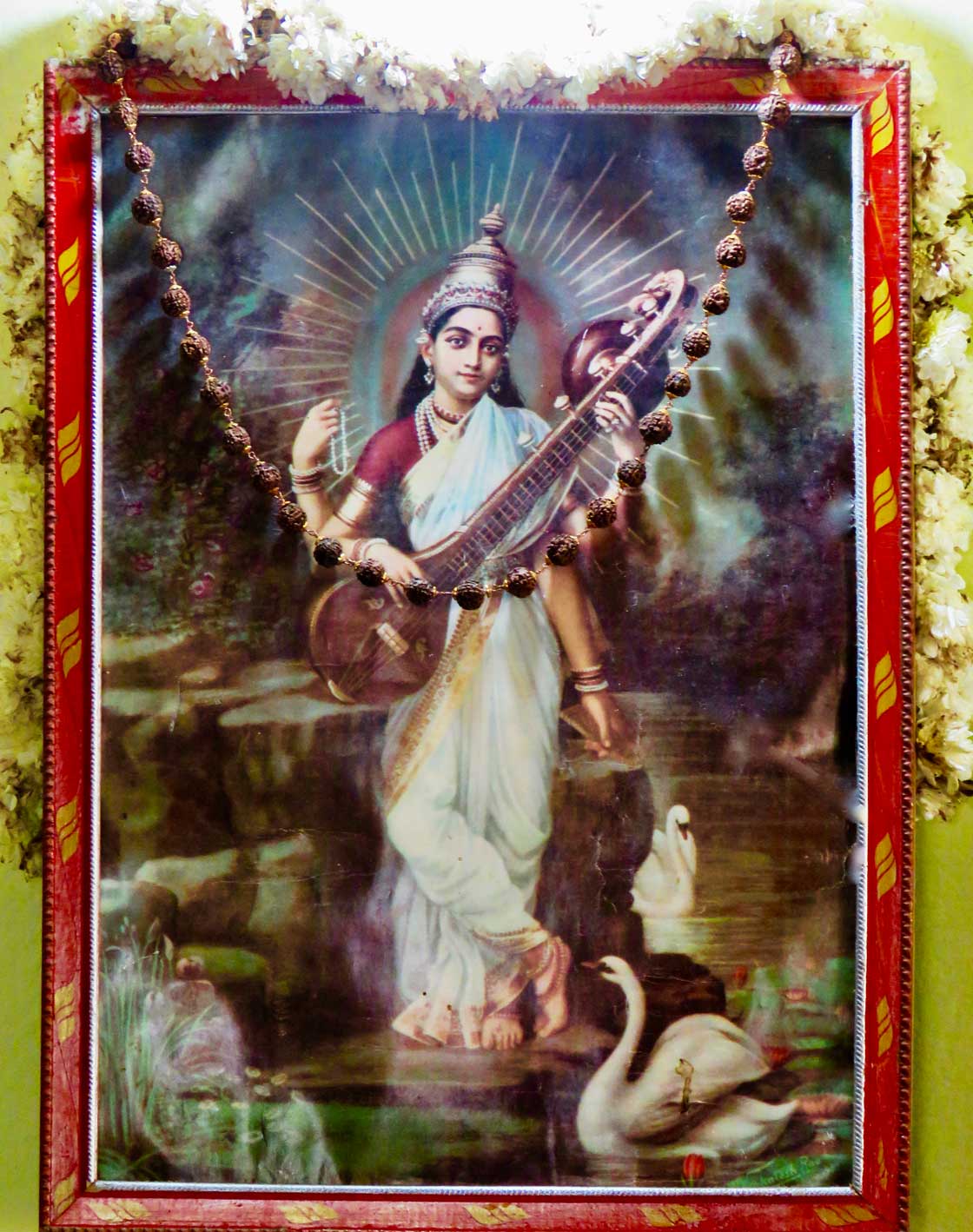 Saraswati Devi An important aspect of the reverence for the divine feminine in the Hindu tradition is the sanctity we place on the sacredness of the land itself which is known as Bharat Mata or Mother India. Not only is India herself considered as a goddess but the very earth is worshipped as a goddess. In the Vedas the goddess earth is praised as Prthivi. She is our first mother. From earth we have been born and back to earth we shall go when we die. It has always been part of our tradition to touch the ground, Prithvi, our first mother, as soon as we get out of bed in the morning and ask her forgiveness for stamping on her breast during the course of the day. Our children were taught at a young age to revere her great stability and inexhaustible fecundity. Our reverence for our rivers and mountains also stem from this. Our rivers are known as goddesses since the ancients knew that they were the arteries of the country- our very life blood, pumping their inexhaustible fund of life- giving waters from the mountains to the sea. Bharat Mata is known as the land of the seven rivers, “Sapta Sindhu.” This is part of the sacred geography of our country. In the Vedas, the river Saraswati was worshipped as the great goddess. This place has been taken by the Ganga now. Westernisation however brought forward the idea of the dominance of the male and the women’s liberation movement was started by western women. It could never have been started in India since Indian women have always thought themselves to be never bound so why should they be liberated? Why should we ever want to be equal? We are different and we take pride in being different. How boring life would be if everything was equal. Life becomes an adventure when we see that everything is different and everyone has a unique role to play in the drama. The whole idea of inferiority came only after the Muslim conquest and British colonialism. It was only in the 20th century that the educated women of India started to demand their rights. They came to believe that they had always been subjugated by the male and reduced to the role of mere chattels. This idea has never been there in the history of our culture. Manu was not a woman hater as some modern women keep quoting from some western view point. All he said was that women should be protected at all times since to them had been given the priceless task of bringing forth and caring for the new generation. What doubt that they should be venerated as goddesses. Even now in the villages every woman’s name will end in “Devi” or “goddess”. She will be known as “Nirmala Devi, Kalyani Devi, Sulochana Devi etc.” Even if they have some modern name as “Poonam” or “Sakshi”, the moment they get married, the word “Devi” is added to their names. This maybe a gentle reminder to the husband that she is to be treated as a goddess! One of the greatest tragedies of modernization is the fact that now every Indian woman wants to be like a man like her western counterpart. If nature wanted her to be a man, it would have made her like a man. But the fact is that a woman is different, physiologically, psychologically and emotionally. Why can’t she take pride in this and not feel ashamed of it. Why should she want to ape men? This is a sort of ideological brain washing given by the West. Unfortunately our ideas are controlled by western society especially American. If they wear torn pants we also follow dumbly. Our girls dress like men, cut their hair like men and generally think it’s something great to be thought of as equal to men. Why have we imbibed this inferiority complex from the west? Women are unique just as men are unique. Why do we go in for unisex clothes and haircuts? By this we are just laying ourselves open to sarcasm. Do men ever think of wearing women’s clothing and pretending to be women, so why should we do it unless we feel inferior and what reason is there for us to feel inferior. We are neither inferior nor superior. We are what we are and we have every reason to feel proud of our feminity. We might be able to do most things that a man can but certainly no man can do everything that we can! Our culture always taught us to take pride in our feminity. Let no Indian women be lured into this false western propaganda that we are inferior. Through the ages we have been given stories of the great women of our times and of our past history. Only with the Muslim invasion were we made to feel that we were a separate and inferior creation. North Indian women started covering their heads only with the onset of the Muslims. South Indian women never had this habit since they were less exposed to Muslim influence. With the loss of feminity, any society will become money oriented. It will start to lose its charm, artistic outlook and start concentrating only on the acquisition of wealth which is what is happening to us right now. 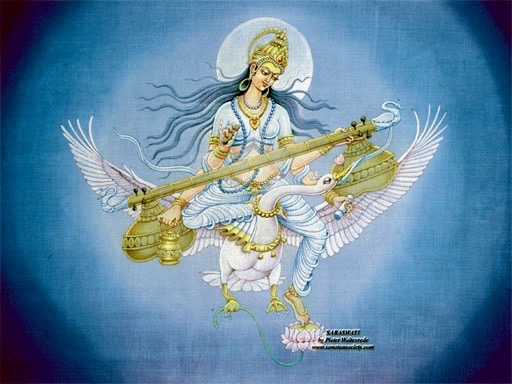 Saraswati Devi The goddess cult in India is kept alive by the celebration of Navaratri or the nine days of the worship of the goddess in her three most important roles of Durga- the virgin, eighteen handed goddess who needs no support from any male consort. Her eighteen hands carry every type of weapon one might need for self defence as well as for combating any type of problem that might arise in our lives. She is totally self-sufficient and competent to overcome any hindrance in the path of progress both materially and spiritually. Next comes Lakshmi, the consort of Vishnu who provides us with all the love and beauty that our life craves for. The third aspect is the Goddess Saraswati, the mother of all arts and sciences. Knowledge of all types streams from her alone. Both artist and scientist have to get her favour before they can succeed in their mission. In this way our culture saw to it that the importance of the feminine is accentuated and kept alive in our minds by the festival known as Navaratri which is celebrated twice a year, once in Spring and once in Autumn. Having been born into such a culture let all Indian women shake off the inferiority that has been falsely thrust upon them by the west and start to live up to the great models that have been placed before us by our ancient culture – the Sanatana Dharma. Hari Aum Tat Sat. 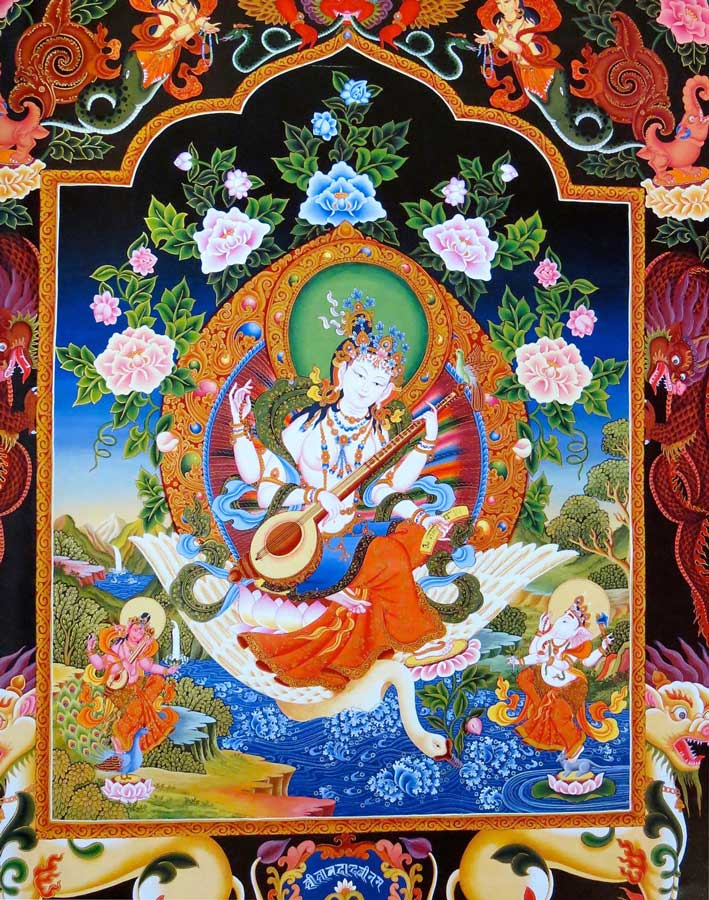 Saraswati Devi The Indian festival of Navaratri (that usually happens in October) is dedicated to the feminine nature of the divine. Durga, Lakshmi and Saraswati are seen as three dimensions of the feminine, symbolic of the earth, the Sun and the Moon, or of tamas (inertia), rajas (activity, passion) and satva (transcendence, knowledge, purity) respectively. Those who aspire for strength or power worship forms of the feminine such as Mother Earth or Durga or Kali. Those who aspire for wealth, passion or material gifts worship Lakshmi or the Sun. Those who aspire for knowledge, dissolution or the transcendence of the limitations of the mortal body worship Saraswati or the Moon.
Saranam Ayyappa Swami!
MYTH ABOUT MENSTRUATION Our
Puranas describe the human body as the city of nine gates. These are
the nine orifices in our body – two eyes, two ears, two nostrils, one
mouth, and the two lower orifices. The seven above the navel are the
gates through which the citadel of the body gets all the information
necessary for its survival in the world. The two lower gates are
primarily meant for elimination. The body is really a perfect
organism. The processes of assimilation, digestion and elimination keep
going on without our knowledge. We are mostly aware of the ingestion
which takes place but not conscious of the digestion and elimination.
But elimination is a most necessary part of the cleansing process which
is absolutely essential to a healthy system. Imagine a house that is
never swept or cleaned!
The best part of the food we eat is digested and assimilated and the waste is thrown out as feces through the anus. The major portion of the water and liquids we drink is assimilated and the rest thrown out as urine. There are other processes of elimination like phlegm, spit, snot, sweat, farts etc. All these are the same for both males and females but the female body has been given an extra method of cleaning itself and that is through the process of menstruation when the unfertilized eggs and the impure blood in the body is expelled from the uterus. There are no myths connected with feces, urine, spit and phlegm because these are common to both genders BUT there are a lot of misconceptions and taboos related to menstrual blood since men don’t have it. Since we have been living in a male dominated society for centuries these myths have been carried down from generation to generation and women have meekly accepted them. In this glorious age of women’s emancipation it is high time that someone tried to unravel these unnecessary misconceptions shrouding the very natural process of menstruation. The great controversy going around the entry of women into the temple of Sabarimala seems to be the right time to write an article to clear up these misconceptions. 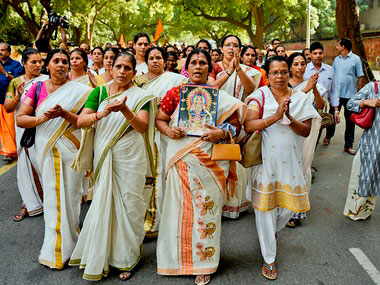 Lord Ayyappa Devotees Protesting Another point to be noted is that everyone likes to be private when anything is eliminated from their body. It is normally never done in public even though many men have no such inhibitions when they want to urinate! Spit is known to be a carrier of germs yet in India nobody thinks anything of spitting all over the place! How healthy or impure is that!! However even in India no one would tolerate if a person started coughing and spitting all over the place in the midst of a theater or music performance! This is all pretty obvious to everyone but since menstruation is one thing which is unique to women, men have made a big fetish about it and woven all sorts of superstitious nonsense around it. This is of course the obvious answer but as with everything in the Sanathana Dharma, there is a very good scientific and humanitarian reason for keeping women away from public places during her monthly periods. Our culture has always recognized the unique role played by women in the production of the new generation. Every society has to take utmost heed to ensure that the future generations are taken care of, if the culture has to be preserved. This has always been recognized in the Sanatana Dharma. Thus every effort was made to protect and look after the woman especially during the season of her monthly periods and during the ten months of gestation and for another three months after the baby was born. This was done with the purest of intentions but modern women have been so influenced by western thought that they think that this was all done by a male dominated society to suppress and depress them. 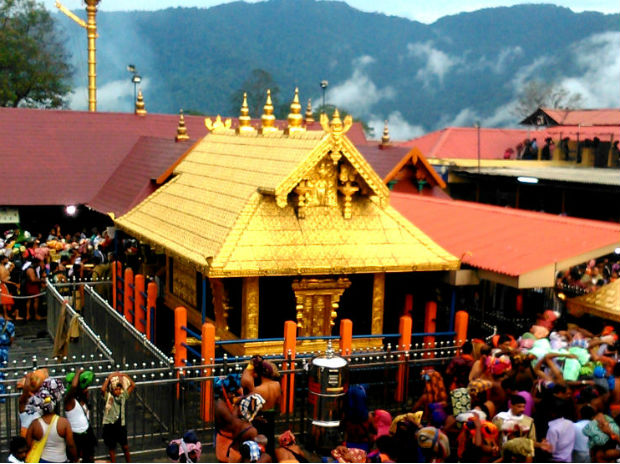 Sabarimala Now
let us examine the scientific reasons for women not entering temples
during menstruation. The human body has five forces called “vayus” or
“winds” which are responsible various different processes in our body,
like digestion, assimilation and ejection. These are called prana,
apana, udana, vyana and samana. Each of these has its own function and
area of control. Prana is the life force, taken in with every inhalation
that courses through our body through certain pathways called “nadis.”
These are subtle forces that actually run parallel to our nervous
system. The “vayu” or energy known as “samana” is responsible for
absorbing the food we take. This refers not just to physical food but
also to the knowledge that we intake through the five senses. Vyana
distributes the nutrients to the different parts of the body as and when
required. Apana is the downward wind that is in charge of the excretory
functions. It removes carbon dioxide, urine and faeces. Udana connects
the brain stem with the cardiac plexus.
Apart
from these main “vayus” or “winds”, the body also has something called
“upavayus” which are subsidiary to the major five and take care of
certain special functions especially in the female body. The upavayu
called “prasoothi” is found in the uterus and female genitals. It exerts
a strong downward force during menstruation and at the time of the
birth of a baby. Actually it starts to function from the eighth month
onwards and brings the head of the fetus downwards and of course creates
the strong force which eventually pushes the baby out at the time of
birth.
Temples are places where the pranic current is very active and allow our minds and energies to rise upward towards the higher chakras or wheels of psychic energy. When we go to the temple during the times when the pranic current called “prasoothi” is active, we will be setting up a counter and downward force which according to our rishis would result in infertility, endometriosis, blocking of tubes etc. This is one of the scientific reasons for forbidding menstruating women and pregnant women over eight months from going to temples or places of worship. So our ancient taboos against temple entry have nothing to do with the defiling of the deity or the impurity of the woman. It was only meant as a protection for her own health. Since most people are reluctant to take any advice given for health reasons, in olden days they were made into taboos which later started accumulating sinister touches like impurity etc. I’m sure that ignorant men who knew nothing about our ancient culture took this as an opportunity to suppress and control women!! We must understand that these rules apply not just to Sabarimala but to all Hindu temples but in all temples it was left to the discretion of the woman whereas in Sabarimala, the rules were made stringent. It is absurd to suppose that a deity, that is the essence of purity, can ever be defiled. No doubt male arrogance and desire to prove himself superior in all ways to women encouraged the creation of such ridiculous superstitions and taboos that exist today. It is high time that all people should be educated about the truth of the extremely pure state of menstruation and this education should also be given to our girls so that they are never made to feel unclean or dirty during that period and are given the freedom to choose whether they want to follow the rules pertaining to their own health which our wise culture has given from ancient times. They can chant their own mantras at all times but should refrain from taking part in any strenuous sadhana like yogasanas. Let all women understand that menstruation is the miracle that ensures the birth of a new and healthy generation and it is the solemn duty of every woman to protect and perfect a new life which only she is capable of protecting! Hari Aum Tat Sat |
